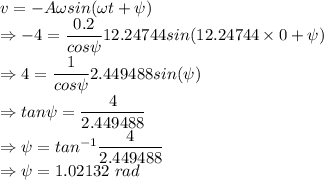
Physics, 13.01.2020 20:31 unknown9263
A2.00-kg, frictionless block is attached to an ideal spring with force constant 300 n/m. at t=0 the block has velocity -4.00 m/s and displacement +0.200 m.
find:
(a) the amplitude and (b) the phase angle.
c) write an equation for the position as a function of time.
assume x(t) in meters and t in seconds

Answers: 2


Another question on Physics

Physics, 22.06.2019 21:30
Which of these statements best explains how the hydrosphere interacts with the atmosphere to affect global climate? mountains block rain clouds and cause changes in global rainfall and evaporation. humans burn fossil fuels to produce greenhouse gases which cause global warming. humans cut down trees which affects the amount of oxygen in different parts of the globe. greenhouse gases, like carbon dioxide, dissolve in oceans and prevent global warming.
Answers: 1

Physics, 22.06.2019 22:30
Isobars are lines of constant or equal pressure on a weather map. they can be used to find areas of low or high pressure over a broad area, and they can tell us how intense the system may be. on weather maps, you may have noticed areas that have a large l or h over a region with lines circling around them. the l stands for low pressure and h stands for high pressure. the lines circling them are isobars. check out the pressure system and isobars over georgia and florida. what is the present weather in this area ? a) clear and sunny b) cold and cloudy c) changing weather d) lots of precipitation
Answers: 3

Physics, 22.06.2019 23:00
Acommon technique in analysis of scientific data is normalization. the purpose of normalizing data is to eliminate irrelevant constants that can obscure the salient features of the data. the goal of this experiment is to test the hypothesis that the flux of light decreases as the square of the distance from the source. in this case, the absolute value of the voltage measured by the photometer is irrelevant; only the relative value conveys useful information. suppose that in part 2.2.2 of the experiment, students obtain a signal value of 162 mv at a distance of 4 cm and a value of 86 mv at a distance of 5.7 cm. normalize the students' data to the value obtained at 4 cm. (divide the signal value by 162.) then calculate the theoretically expected (normalized) value at 5.7 cm.
Answers: 2

Physics, 23.06.2019 01:00
2. circled insects have mutations, or changes to their dna. how many of the offspring insects in this generation have mutations?
Answers: 2
You know the right answer?
A2.00-kg, frictionless block is attached to an ideal spring with force constant 300 n/m. at t=0 the...
Questions




English, 29.06.2019 18:00

Mathematics, 29.06.2019 18:00

Mathematics, 29.06.2019 18:00

Mathematics, 29.06.2019 18:00

Biology, 29.06.2019 18:00

English, 29.06.2019 18:00



Mathematics, 29.06.2019 18:00

Biology, 29.06.2019 18:00


Biology, 29.06.2019 18:00

Mathematics, 29.06.2019 18:00

Geography, 29.06.2019 18:00











